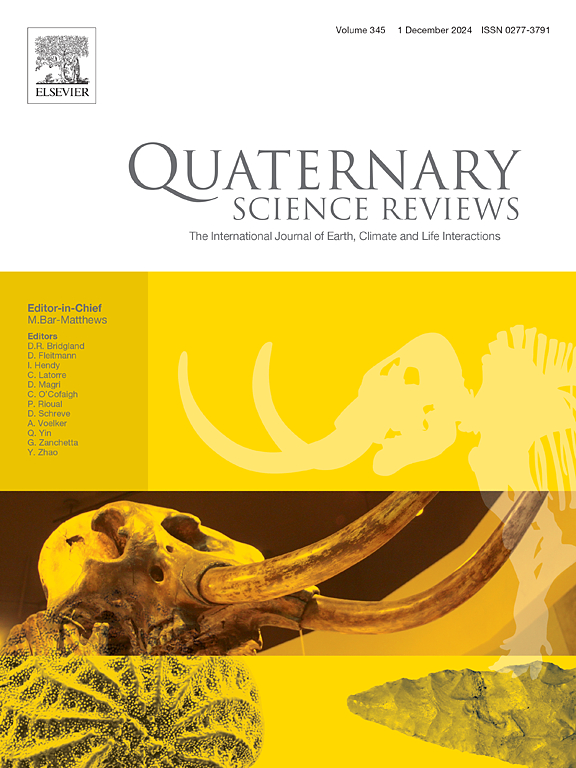Impacts of sea level rise and climate change on the sources, preservation and thermal stability of sedimentary organic carbon in the East China Sea inner shelf since the last deglaciation
IF 3.2
1区 地球科学
Q1 GEOGRAPHY, PHYSICAL
引用次数: 0
Abstract
Large river-dominated marginal seas are important hotspots for organic carbon (OC) burial, yet the long-term preservation of OC from diverse sources and with varying reactivities remains poorly understood. Specific surface area (SSA), median grain size (MGS), total OC (TOC) contents and its stable isotopic composition (δ13C), lignin phenols, chlorophyll pigments and thermogravimetric properties of sediments from a gravity core collected from the East China Sea (ECS) inner shelf were analyzed. The overarching objective was to evaluate the impacts of sea level rise and climate change on the sources, preservation and thermal stability of SOC in the ECS inner shelf since the last deglaciation. Prior to seawater intrusion (before 13.2 ka BP), bulk parameters such as TOC and MGS varied slightly, with terrestrial OC being the predominant source. With the sea level rise during the Bølling-Allerød (BA), Younger Dryas (YD) and early Holocene periods (13.2–7.5 ka BP), marine OC increased due to enhanced marine primary production. When the modern current system was established (after 7.5 ka BP), the marine OC decreased along with the increase of soil and plant-derived OC, due in part to increased terrestrial inputs from the Changjiang. Notably, the abrupt cold events occurring during the YD and Holocene periods displayed a significantly higher proportion of terrestrial plant-derived OC with low thermal stability and elevated TOC/SSA ratios. In contrast, thermally stable soil-derived OC was effectively preserved during the mid-late Holocene due to the enhanced East Asian winter monsoon (EAWM) and reduced precipitation. These findings highlight the significance of sea level rise and climate change, especially extreme climate events in the sequestration of OC in coastal sediments.
末次冰期以来海平面上升和气候变化对东海内陆架沉积有机碳来源、保存和热稳定性的影响
大型河流主导的边缘海是有机碳(OC)埋藏的重要热点,但对不同来源和不同反应性的OC的长期保存仍知之甚少。对东海陆架重力岩心沉积物的比表面积(SSA)、中位粒径(MGS)、总OC (TOC)含量及其稳定同位素组成(δ13C)、木质素酚类、叶绿素色素和热重性质进行了分析。总体目标是评估末次冰期以来海平面上升和气候变化对ECS内陆架有机碳来源、保存和热稳定性的影响。在海水入侵之前(13.2 ka BP之前),TOC和MGS等总体参数变化不大,以陆源OC为主。在b ø ling- allerø d (BA)、新仙女木期(YD)和全新世早期(13.2 ~ 7.5 ka BP),随着海平面的上升,海洋OC的增加是由于海洋初级生产的增强。现代海流系统建立后(7.5 ka BP以后),海洋OC随着土壤和植物源OC的增加而减少,部分原因是由于长江陆源OC的增加。值得注意的是,在YD和全新世期间发生的突发性冷事件中,陆生植物来源的OC比例显著增加,热稳定性低,TOC/SSA比值升高。而在全新世中后期,由于东亚冬季风(EAWM)的增强和降水的减少,热稳定的土壤OC得到了有效的保存。这些发现强调了海平面上升和气候变化,特别是极端气候事件对沿海沉积物中有机碳封存的重要性。
本文章由计算机程序翻译,如有差异,请以英文原文为准。
求助全文
约1分钟内获得全文
求助全文
来源期刊

Quaternary Science Reviews
地学-地球科学综合
CiteScore
7.50
自引率
15.00%
发文量
388
审稿时长
3 months
期刊介绍:
Quaternary Science Reviews caters for all aspects of Quaternary science, and includes, for example, geology, geomorphology, geography, archaeology, soil science, palaeobotany, palaeontology, palaeoclimatology and the full range of applicable dating methods. The dividing line between what constitutes the review paper and one which contains new original data is not easy to establish, so QSR also publishes papers with new data especially if these perform a review function. All the Quaternary sciences are changing rapidly and subject to re-evaluation as the pace of discovery quickens; thus the diverse but comprehensive role of Quaternary Science Reviews keeps readers abreast of the wider issues relating to new developments in the field.
 求助内容:
求助内容: 应助结果提醒方式:
应助结果提醒方式:


